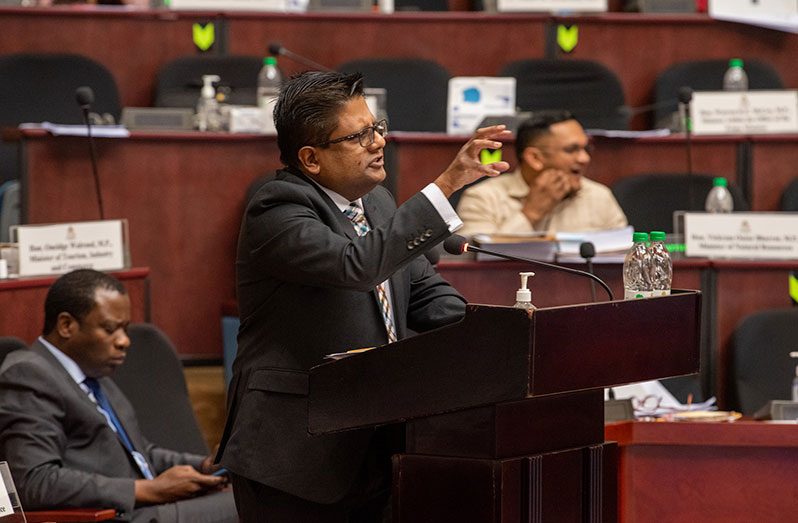–state-of-the-art abattoirs to be constructed
–commercial trials of corn, soya bean cultivation to begin soon
RECOGNISING the potential that exists for further growth in the livestock industry, the government intends to invest $997.3 million to empower existing and potential farmers, and also create the conditions necessary for future expansion.
Included in the plans for the livestock industry is the establishment of a modular swine abattoir at Garden of Eden, on the East Bank Demerara. This facility, which will be constructed through a partnership between the government and the private sector, would have better standardised production systems and biosecurity that would benefit over 600 farmers.
Also, as outlined by Senior Minister in the Office of the President with responsibility for Finance, Dr. Ashni Singh, during his presentation of Budget 2022 to the National Assembly, the government will facilitate the establishment of a modern abattoir at Onverwagt, Region Five (Mahaica-Berbice).
This facility, which is expected to be completed by 2023, will focus primarily on beef and beef products, and be supplemented by pasture development, which is a priority for the resuscitation of the dairy industry.
The establishment of those facilities will be supported by the requisite certification processes and traceability capacity, which would allow Guyana to access regional and international markets.
In Guyana, the livestock sub-sector contributes approximately 13.6 per cent of the agricultural Gross Domestic Product (GDP) and 2.8 per cent of the total GDP. Livestock is commonly defined as domesticated animals raised in an agricultural setting to produce labour and commodities such as meat, eggs and milk, among other things.
The livestock industry grew by an estimated at 9.2 per cent in 2021, despite the losses suffered as a result of periodic flooding.
Speaking on the performance of this industry, Dr. Singh said the increase was on account of growth in the production of poultry meat, beef, pork and mutton, which were estimated to have expanded by 16.5 per cent, 13.9 per cent, 23.6 per cent and 21.3 per cent, respectively, when compared with figures recorded in 2020.
“These more than offset the estimated declines in the production of eggs and milk. The increase in production reflects the growth in demand which followed the relaxation of COVID-19 restrictions on restaurants and other food establishments, combined with high demand in the oil and gas and mining sectors,” the senior minister related.
To empower farmers and increase their competitiveness, the government took a strategic decision in 2021, to support the local private sector in a trial cultivation of approximately 200 aces of corn and soya bean.
That specific project was adopted because, historically, Guyana’s livestock feed supplies have largely been imported, with the poultry industry consuming approximately 113,000 tonnes annually.
Given that livestock feeds typically comprise 60 per cent corn and rice and 30 per cent soya beans, the recent global supply chain disruptions to imports have transmitted this vulnerability to the domestic food chain.
In light of this, the government took the initiative to rehabilitate 47 kilometres of a vital farm-to-market road – the Ituni-Tacama road – starting from the junction of the Linden-Ituni road and heading east, towards the Berbice River.
Upon completion, this project will open up approximately 61,000 hectares of prime farmland in the Tacama, Wiruni, and Ebini Savannahs on the eastern side of the Berbice River.
Essentially, that will create space for the expansion of the corn and soya bean cultivation, which has so far produced positive results.

COMMERCIAL TRIALS
“Mr. Speaker, I am pleased to report that the success of this trial has led to a decision by the private sector to increase to 2,700 acres for commercial trials in 2022. This will result in 1,500 tonnes of soya bean and 3,000 tonnes of corn being harvested in the second half of this year,” Dr. Singh said.
With the anticipated success of the commercial trial, cultivation is expected to ramp up to 12,500 acres in 2023, 25,000 acres in 2025 and 56,000 acres in 2028. To this end, $102 million was expended in 2021 and a further $426 million is budgeted in 2022 to complete the road to facilitate the expansion of the project.
Further, required storage for anticipated harvests saw approximately $236 million being budgeted to procure a drying and storage facility, with an additional $225 million budgeted in 2022 for the additional works and installation.
This initiative sets the stage for large-scale cultivation of corn and soya bean, and related agro-business development in the Tacama area.
As a result of this and other investments, the livestock industry is on course to expanding this year, with a projected growth rate of 13.6 per cent.
When the People’s Progressive Party/Civic (PPP/C) government assumed office in August 2020, the Value Added Tax (VAT) on fertilisers, agrochemicals, pesticides and key inputs in the poultry sector, including poultry feed, building materials and packaging were removed; the government also gave the poultry industry zero-rated VAT status.
Since those adjustments, there has been a stark increase in investments in this industry, with about 500 new farmers getting into poultry farming between August and December 2020 alone.
Minister of Agriculture, Zulfikar Mustapha, has said that the increased interest in this industry augurs well for Guyana, and will supplement the growth of the country’s burgeoning oil-and-gas sector.
In his 2021 national budget speech, Minister Mustapha said that the measures introduced in the government’s 2020 budget initiated a reversal of all the challenges facing the livestock industry, and approximately 5,000 small farmers and broiler producers.
Going forward, Minister Mustapha said that much emphasis will be placed on exporting meats and gaining access to emerging markets, especially the high-end supermarkets and hotels, as well as players within the mining and petroleum sectors.
Outside of Guyana, in the Caribbean region, the Food and Agriculture Organization (FAO) has predicted that the demand for food will increase 50 per cent by 2030 and 70 per cent by 2050.
And, according to the FAO, livestock production constitutes a very important component of the agricultural economy of developing countries, a contribution that goes beyond direct food production to include multipurpose uses, such as skins, fibre, fertiliser and fuel, as well as capital accumulation.




.png)









